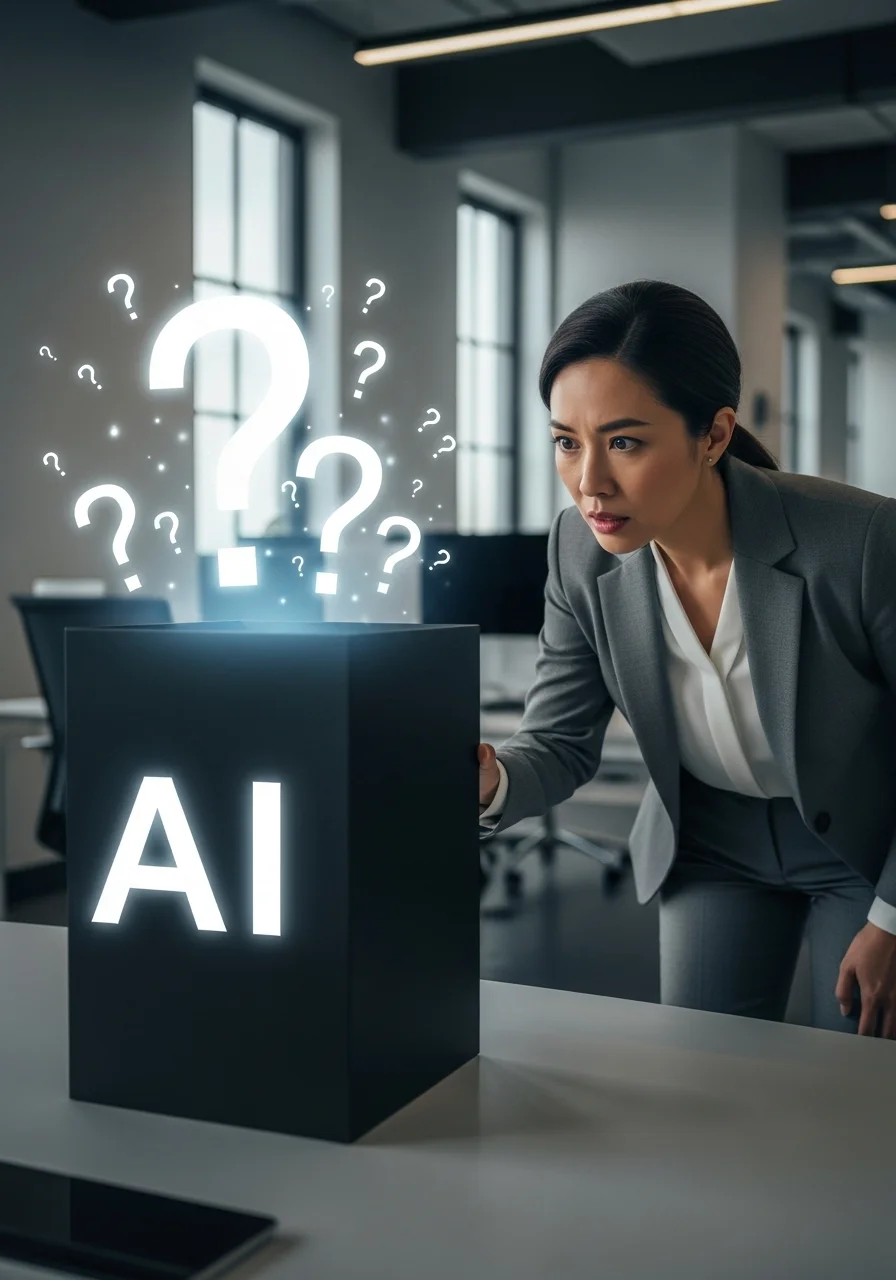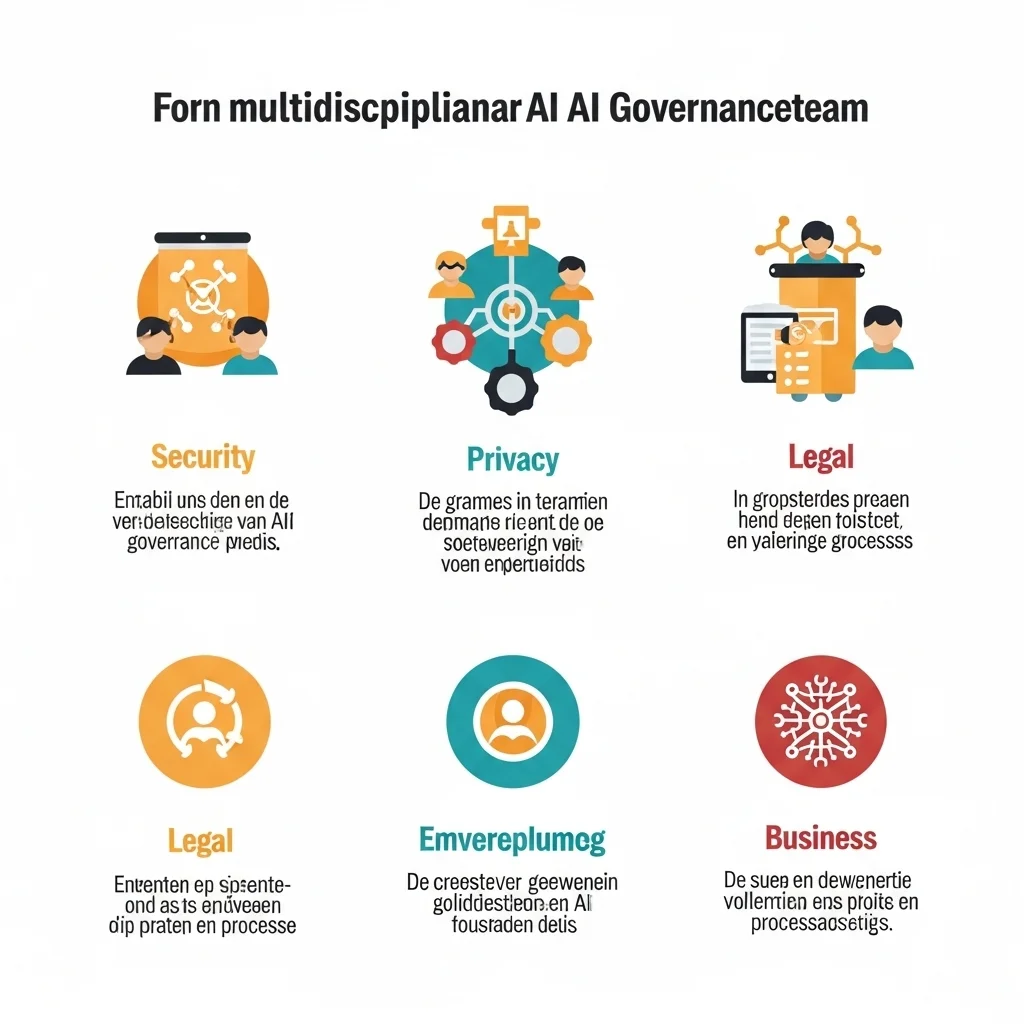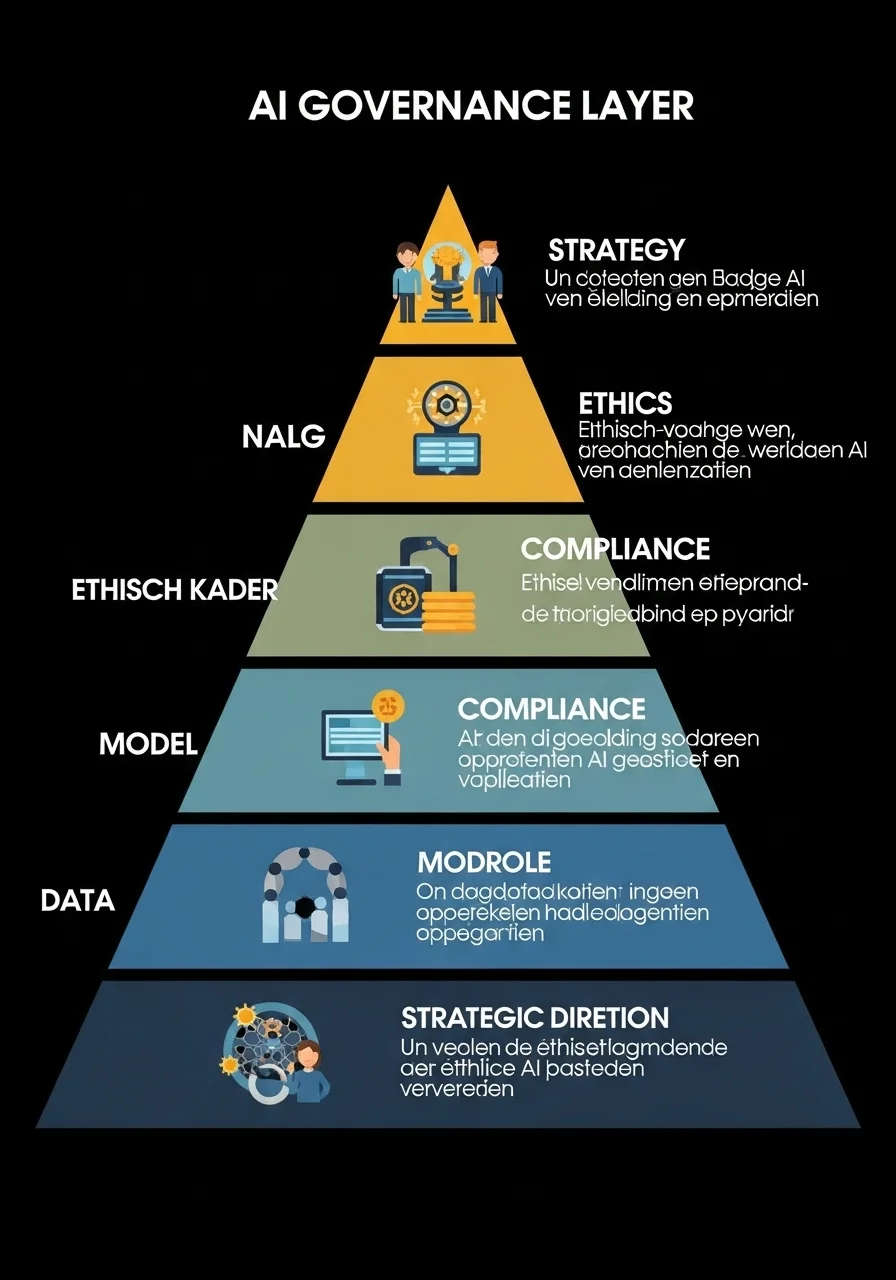Bedankt voor uw bericht!
We nemen zo snel mogelijk contact met u op.
Contact opnemen?
Heeft u vragen over dit artikel of onze services? Neem contact op!
Is AI the new superpower or the Achilles heel of your security and privacy strategy?
Artificial intelligence is no longer science fiction; it is reshaping the roles of the CISO and Privacy Officer right now. Discover how to turn this technological storm into a strategic advantage instead of drowning in it.
Is AI the new superpower or the Achilles heel of your security and privacy strategy?
Artificial intelligence is no longer science fiction; it is reshaping the roles of the CISO and Privacy Officer right now. Discover how to turn this technological storm into a strategic advantage instead of drowning in it.
The double role of AI
A double-edged sword?
How AI simultaneously empowers and challenges the CISO and Privacy Officer.
Defensive superpower
AI systems continuously analyse vast volumes of data to spot anomalies and potential threats, often long before a human analyst could. Think automated threat hunting and predicting possible attack vectors.
Attackers' toy of choice
Cybercriminals use the same technology for hyper-realistic phishing emails, generating polymorphic malware that changes shape, and even deepfake videos for social engineering. The arms race has officially started, and AI is the preferred weapon on both sides.
Privacy's guardian
Complex algorithms can automatically identify and classify personal data (PII) in unstructured datasets. This makes carrying out a DPIA or responding to access requests far more efficient.
Privacy's nightmare
AI models, particularly large language models, are data-hungry. They raise tricky questions about data minimisation, bias in training data and the risk of model inversion attacks, where sensitive training data can be extracted from the model.

The CISO in the AI era: from gatekeeper to strategist
How artificial intelligence is fundamentally rewriting the cybersecurity rulebook.
Have you ever wondered what the security landscape will look like in five years? I have, and my answer is becoming clearer: it will be dominated by AI. For a Chief Information Security Officer, this is both exciting and terrifying. For years, our role was largely reactive: we built walls, installed gates and responded to alarms. AI changes that playing field completely.
It is a shift from reaction to prediction, and we are already seeing it in practice. Modern SIEM (Security Information and Event Management) and SOAR (Security Orchestration, Automation and Response) platforms are virtually unthinkable without AI. They can correlate millions of data points per second to spot subtle attack signals that would remain invisible to a human team. Picture an employee suddenly logging in at night from an unusual location and accessing files outside their normal duties. A traditional system sees three separate, perhaps innocent events. An AI-driven system sees a pattern and raises the alarm proactively.
The new arms race: security for AI
The interesting thing is how quickly the focus is shifting. It is no longer just about deploying AI for security. The real challenge we now face as developers and strategists is security for AI. Because what happens when your own AI models become the target?
Recently I came across a fascinating example of adversarial AI. Researchers managed to fool an image-recognition model by invisibly changing just a few pixels. To the human eye it was still a stop sign, but the AI identified it with 99% certainty as a washing machine. Now translate that to a security context: what if an attacker can trick your AI-driven malware detection in the same way?
This means that, as developers and security experts, we need to secure the AI development pipeline (MLOps) itself.
Data poisoning: How do you make sure the data used to train your model is trustworthy and intact?
Model integrity: How do you validate that the model in production is still the same one you tested?
Input validation: How do you prevent malicious actors from sending deliberately manipulated data to crash or mislead your model?
The CISO is no longer merely a buyer of security tools but a strategic partner who must deeply understand how AI systems are built, trained and deployed. That is a big change, but an incredibly exciting one.
The Privacy Officer and the 'black box'
Navigating the minefield of data, ethics and the impending EU AI Act.
If the CISO lies awake at night worrying about adversarial AI, the Privacy Officer lies awake worrying about the black box. Many complex AI models, especially deep-learning networks, are inherently opaque. They provide an output, but it is extremely difficult to pinpoint exactly why they reached a particular conclusion. That clashes with one of the core principles of the GDPR: the right to an explanation.
Imagine an AI model is used to screen job applicants. If a candidate is rejected, you must be able to explain which factors led to that decision. If the answer is "because the algorithm said so", your organisation has a serious problem. This is where Explainable AI (XAI) comes in. It is a growing field that develops techniques to make AI decision-making more transparent. At Spartner we see this as a crucial part of building responsible software. It is no longer enough that it works; we must also prove how it works.
The shadow of the EU AI Act
And then there is the elephant in the room: the EU AI Act. This upcoming legislation is often dubbed the "GDPR for AI" and will have enormous impact. The law classifies AI systems by risk level, from minimal to unacceptable. Systems deemed high-risk – think AI in HR, credit scoring or critical infrastructure – will have to meet extremely strict requirements for transparency, data quality, human oversight and robustness.
For Privacy Officers, that means they need to start preparing now.
Take stock: Which AI systems are already being used in the organisation (including the shadow AI that teams adopt themselves, such as ChatGPT)?
Classify: Make a preliminary assessment of the risk level under the AI Act.
Update your DPIAs: The traditional Data Protection Impact Assessment must be expanded with an AI Impact Assessment. This should analyse not only privacy risks but also risks relating to bias, discrimination and ethics.
The Privacy Officer role is evolving from compliance expert to ethical compass for the organisation. It is a challenge that demands deep technological insight combined with a keen eye for societal impact.

How do you get started with an AI-proof security and privacy policy?
A practical step-by-step plan for CISOs and Privacy Officers to take control today.
It may feel like an overwhelming task, but waiting is not an option. Developments are moving too fast. Fortunately, a structured approach can lay a solid foundation. This is how we tackle it in our projects:
Step 1: Create a multidisciplinary AI governance team This is not a task the CISO or Privacy Officer can complete alone. Our approach is to form a team straight away with representatives from Security, Privacy, Legal, IT/Development and the business. Each member brings a unique perspective. The developer knows how the models work, Legal understands the legal risks, and the business sees the opportunities. This collaboration is the key to balanced policy.
Step 2: Start with an AI risk inventory You cannot protect what you do not know. The first and most important step is to map all AI applications within the organisation. Do not forget shadow IT! Many teams are already experimenting with tools such as ChatGPT or Midjourney. Map out: what data goes in? What comes out? And who is responsible?
Step 3: Develop an 'Acceptable Use Policy' for (generative) AI This is both practical and urgent. Employees are using generative AI whether you like it or not. Provide clear guidelines. Is it allowed to paste proprietary code into ChatGPT? May personal data be used in a prompt? A clear policy prevents unintended data leaks and gives staff the clarity they need.
Pro-tip: Do not make it just a list of prohibitions; also explain how to use it safely, for instance by using a corporate account with specific privacy settings.
Step 4: Invest in 'Security for AI', not just 'AI for Security' As discussed earlier, this is the next stage of maturity. Start by asking your development teams or software suppliers questions. How is the training data protected? Are models tested for adversarial attacks? Is there a process for monitoring model bias and drift (when a model becomes less accurate over time)? This shifts the focus from AI as a tool to AI as a critical business asset that needs protection itself.

What fascinates me most about today's developments is the incredible speed with which AI is evolving from a technical toy into a fundamental part of business strategy. For CISOs and Privacy Officers, this is the moment to stand up and claim their role as strategic advisers. Knowing the rules is no longer enough; you need to understand the technology so you can ask the right questions and guide your organisation through this complex new world.
More than a tool, a strategic partner
The key takeaways for every modern CISO and Privacy Officer.
Embrace AI as a defensive weapon: Use the power of AI to automate and accelerate your security analysis. Let algorithms do the heavy lifting so your human experts can focus on complex strategic threats.
Understand the new attack vectors: Realise that your organisation is not the only one with access to AI. Anticipate AI-driven attacks and start securing your own AI systems.
Make governance a priority: Do not wait for an incident. Set up an AI governance structure now. Clear policies and responsibilities are your best defence.
Prepare for regulation: The EU AI Act is coming. Use its principles now as a guide for developing and procuring responsible AI solutions.

The discussion around AI, security and privacy is far from over. In fact, it is only just beginning. As a software development team building tomorrow's solutions every day, we learn something new daily. What are your biggest challenges or unexpected successes in this area? I would love to hear about your experiences. Share them in the comments or let us talk about how we can build safe and responsible AI together.
FAQ
What is currently the biggest AI threat for a CISO?
The most immediate and fast-growing threat is the use of generative AI for social engineering. Think hyper-personalised phishing emails written in perfect Dutch that focus on an employee's role and recent activities. The generation of malicious code and deepfakes for fraud (CEO fraud) are also serious and current risks.
How can a Privacy Officer ensure GDPR compliance when using AI?
This requires a proactive approach. It starts with carrying out a thorough Data Protection Impact Assessment (DPIA) specifically for the AI system. You must examine the legal basis for data processing, necessity and proportionality, and transparency towards data subjects. Our experience shows that applying Privacy by Design is essential: build privacy safeguards in from the start rather than trying to add them later.
What exactly is 'adversarial AI'?
Adversarial AI is a technique in which an attacker deliberately creates manipulated input data to mislead an AI model, causing a wrong classification or prediction. A well-known example is subtly altering pixels in an image, but it can also be applied to text or network traffic to bypass security algorithms.
Is the EU AI Act already in force?
Not fully yet. The EU AI Act was approved in March 2024 and is being phased in. The first provisions (such as the ban on unacceptable AI systems) take effect at the end of 2024, and most other rules follow in the 12 to 36 months after that. Organisations therefore still have time to prepare, but it is crucial to start now given the complexity.
What is the difference between 'AI for Security' and 'Security for AI'?
"AI for Security" refers to using artificial intelligence as a tool to improve cybersecurity, such as detecting malware or analysing threats. "Security for AI" turns the focus around: it is about securing the AI systems themselves, protecting models against attacks like data poisoning, deception and model theft. Both are essential for a mature AI strategy.
Do we really need a Chief AI Officer (CAIO) now?
For large organisations that rely heavily on AI, this is becoming increasingly relevant. The CAIO's role is to develop a holistic, organisation-wide AI strategy that goes beyond technology and also covers ethics, governance and business value. In smaller organisations, these responsibilities can be assigned to the AI governance team led by, for example, the CTO, CISO or CDO.
Can AI help reduce 'alert fatigue' in security teams?
Absolutely. This is one of the biggest benefits of AI for security. Many security teams are inundated with thousands of alerts per day, most of which are false positives. AI can triage and correlate these alerts, escalating only the most likely and dangerous incidents to human analysts. This makes the security team's work both more effective and less frustrating.
Bedankt voor uw bericht!
We nemen zo snel mogelijk contact met u op.
Contact opnemen?
Heeft u vragen over dit artikel of onze services? Neem contact op!
Feel like a cup of coffee?
Whether you have a new idea or an existing system that needs attention?
We are happy to have a conversation with you.
Call, email, or message us on WhatsApp.
